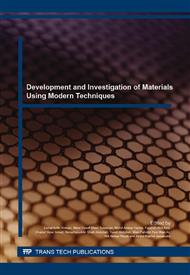p.3
p.8
p.14
p.19
p.24
p.29
p.34
p.39
Titania (TiO2) as Antibacterial Material in Ceramic Tiles: Effect of Composition
Abstract:
Titania (TiO2) is one of a common and favorable material use in the manufacturing industry due to its uniqueness and functional performances to human and environment. The study was focused on the performance of glaze added TiO2 (anatase phase) in the application of porcelain tiles. Anatase powder in micro size was used (varies at 5 wt%, 10 wt % and 15 wt%) to observe their performance as antibacterial materials. The anatase powders were mix into the glaze composition and apply to the porcelain tile through dip coating. The viscosity of each composition was observed to study their effect. Characterization used to observe the properties of anatase mixed glazed porcelain tile were X-ray diffraction (XRD), Scanning electron microscopy (SEM) and antibacterial test. The results shown that higher composition of anatase powder, viscosity of the mixed glaze is higher and a rougher surface of glazed tiles was formed. XRD result shows that the higher the composition is more the intensity of TiO2 on the glaze coating surface, supported by SEM results. Antibacterial testing towards E.Coli was observed by counting the colonies of bacterial growth in 0 hr, 2 hrs, 4 hrs and 8hrs. The antibacterial properties increase when the composition of anatase increases.
Info:
Periodical:
Pages:
14-18
Citation:
Online since:
January 2016
Keywords:
Price:
Сopyright:
© 2016 Trans Tech Publications Ltd. All Rights Reserved
Share:
Citation:


